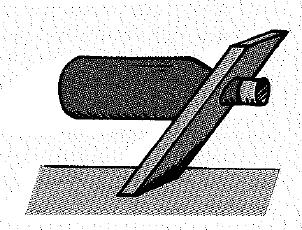
A bottle rack that seems to defy common sense is shown in the figure. Where is the CG of the rack and bottle?

The center of gravity of the rack and bottle.
Answer to Problem 38A
The center of gravity lies directly above the support base of the rack on the table.
Explanation of Solution
Introduction:
The center of gravity of a body is the point where the sum of all the forces that are acting on a body will be equal to zero.
The rack and the bottle are in stable equilibrium because their center of gravity lies about the support point. Had it not been above the support point, an unbalanced force would have caused the toppling of the bottle and the rack. The center of gravity lies directly above the base of the support of the rack on the table.
Conclusion:
Hence, the center of gravity lies directly above the support base of the rack on the table.
Chapter 11 Solutions
Conceptual Physics C2009 Guided Reading & Study Workbook Se
Additional Science Textbook Solutions
Physics for Scientists and Engineers: A Strategic Approach, Vol. 1 (Chs 1-21) (4th Edition)
Chemistry: An Introduction to General, Organic, and Biological Chemistry (13th Edition)
Organic Chemistry (8th Edition)
Campbell Biology in Focus (2nd Edition)
Human Physiology: An Integrated Approach (8th Edition)
College Physics: A Strategic Approach (3rd Edition)
- Please solve all the questions correctly please. Thank you!!arrow_forwardPlease solve this problem correctly please and be sure to provide explanation on each step so I can understand what's been done thank you. (preferrably type out everything)arrow_forwardUse a calculation to determine how far the fishing boat is from the water level .Determine distance Yarrow_forward
- No chatgpt pls will upvotearrow_forward2. 1. Tube Rating Charts Name: Directions: For the given information state if the technique is safe or unsafe and why. 60 Hertz Stator Operation Effective Focal Spot Size- 0.6 mm Peak Kilovolts MA 2 150 140 130 120 110 100 90 80 70 2501 60 50 40 30 .01 .02 .04.06 .1 .2 .4.6 1 8 10 Maximum Exposure Time In Seconds Is an exposure of 80 kVp, 0.1 second and 200 mA within the limits of the single phase, 0.6 mm focal spot tube rating chart above? Is an exposure of 100 kVp, 0.9 second and 150 mA within the limits of the single phase, 0.6 mm focal spot tube rating chart above?arrow_forwardQ: You have a CO2 laser resonator (λ = 10.6 μm). It has two curved mirrors with R₁=10m, R2= 8m, and mirror separation /= 5m. Find: R2-10 m tl Z-O 12 R1-8 m 1. Confocal parameter. b= 21w2/2 =√1 (R1-1)(R2-1)(R1+R2-21)/R1+R2-21) 2. Beam waist at t₁ & t2- 3. Waist radius (wo). 4. 5. The radius of the laser beam outside the resonator and about 0.5m from R₂- Divergence angle. 6. Radius of curvature for phase front on the mirrors R₁ & R2-arrow_forward
- No chatgpt pls will upvotearrow_forwardSARET CRKS AUTOWAY 12. A stone is dropped from the top of a cliff. It is seen to hit the ground below after 3.55 s. How high is the cliff? 13. A ball is dropped from rest at the top of a building that is 320 m tall. Assuming no air resistance, what is the speed of the ball just before it strikes the ground? 14. Estimate (a) how long it took King Kong to fall straight down from the top of the Empire State Building (280m high), and (b) his velocity just before "landing". Useful equations For Constant Velocity: V => D X = V₁t + Xo For Constant Acceleration: Vr = V + at X = Xo+Vot + v=V+2a(X-Xo) \prom = V +V V velocity t = time D Distance X = Final Position Xo Initial Position V = Final Velocity Vo Initial Velocity a = acceleration For free fall Yf = Final Position Yo Initial Position g = 9.80 m $2 For free fall: V = V + gt Y=Yo+Vo t + +gt V,² = V₁²+2g (Y-Yo) V+Vo Vprom= 2 6arrow_forwardSolve the problemsarrow_forward
 College PhysicsPhysicsISBN:9781305952300Author:Raymond A. Serway, Chris VuillePublisher:Cengage Learning
College PhysicsPhysicsISBN:9781305952300Author:Raymond A. Serway, Chris VuillePublisher:Cengage Learning University Physics (14th Edition)PhysicsISBN:9780133969290Author:Hugh D. Young, Roger A. FreedmanPublisher:PEARSON
University Physics (14th Edition)PhysicsISBN:9780133969290Author:Hugh D. Young, Roger A. FreedmanPublisher:PEARSON Introduction To Quantum MechanicsPhysicsISBN:9781107189638Author:Griffiths, David J., Schroeter, Darrell F.Publisher:Cambridge University Press
Introduction To Quantum MechanicsPhysicsISBN:9781107189638Author:Griffiths, David J., Schroeter, Darrell F.Publisher:Cambridge University Press Physics for Scientists and EngineersPhysicsISBN:9781337553278Author:Raymond A. Serway, John W. JewettPublisher:Cengage Learning
Physics for Scientists and EngineersPhysicsISBN:9781337553278Author:Raymond A. Serway, John W. JewettPublisher:Cengage Learning Lecture- Tutorials for Introductory AstronomyPhysicsISBN:9780321820464Author:Edward E. Prather, Tim P. Slater, Jeff P. Adams, Gina BrissendenPublisher:Addison-Wesley
Lecture- Tutorials for Introductory AstronomyPhysicsISBN:9780321820464Author:Edward E. Prather, Tim P. Slater, Jeff P. Adams, Gina BrissendenPublisher:Addison-Wesley College Physics: A Strategic Approach (4th Editio...PhysicsISBN:9780134609034Author:Randall D. Knight (Professor Emeritus), Brian Jones, Stuart FieldPublisher:PEARSON
College Physics: A Strategic Approach (4th Editio...PhysicsISBN:9780134609034Author:Randall D. Knight (Professor Emeritus), Brian Jones, Stuart FieldPublisher:PEARSON





